Input interpretation

L-tryptophan
Chemical names and formulas
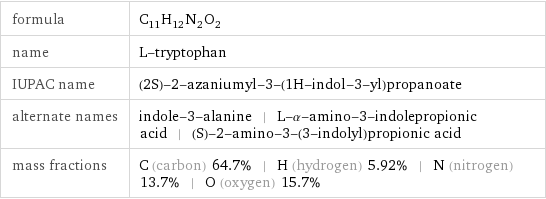
formula | C_11H_12N_2O_2 name | L-tryptophan IUPAC name | (2S)-2-azaniumyl-3-(1H-indol-3-yl)propanoate alternate names | indole-3-alanine | L-α-amino-3-indolepropionic acid | (S)-2-amino-3-(3-indolyl)propionic acid mass fractions | C (carbon) 64.7% | H (hydrogen) 5.92% | N (nitrogen) 13.7% | O (oxygen) 15.7%
Lewis structure
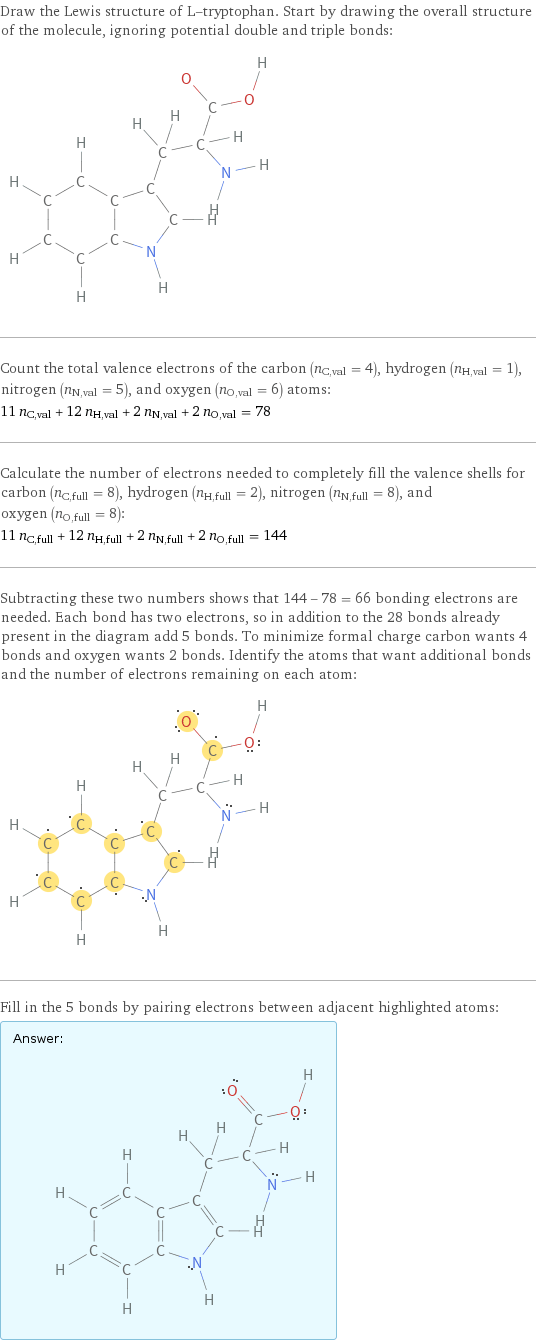
Draw the Lewis structure of L-tryptophan. Start by drawing the overall structure of the molecule, ignoring potential double and triple bonds: Count the total valence electrons of the carbon (n_C, val = 4), hydrogen (n_H, val = 1), nitrogen (n_N, val = 5), and oxygen (n_O, val = 6) atoms: 11 n_C, val + 12 n_H, val + 2 n_N, val + 2 n_O, val = 78 Calculate the number of electrons needed to completely fill the valence shells for carbon (n_C, full = 8), hydrogen (n_H, full = 2), nitrogen (n_N, full = 8), and oxygen (n_O, full = 8): 11 n_C, full + 12 n_H, full + 2 n_N, full + 2 n_O, full = 144 Subtracting these two numbers shows that 144 - 78 = 66 bonding electrons are needed. Each bond has two electrons, so in addition to the 28 bonds already present in the diagram add 5 bonds. To minimize formal charge carbon wants 4 bonds and oxygen wants 2 bonds. Identify the atoms that want additional bonds and the number of electrons remaining on each atom: Fill in the 5 bonds by pairing electrons between adjacent highlighted atoms: Answer: | |
3D structure
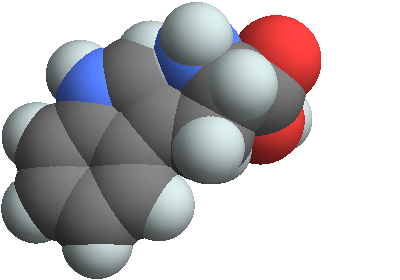
3D structure
Basic properties

molar mass | 204.23 g/mol phase | solid (at STP) melting point | 290 °C density | 1.34 g/cm^3
Units

Hydrophobicity and permeability properties

experimental LogP hydrophobicity | -1.3 predicted LogP hydrophobicity | -1.09 experimental LogS | -1.23 predicted LogS | -2.18
Basic drug properties

approval status | approved | nutraceutical | small molecule drug categories | second-generation antidepressive agent | dietary supplement | essential amino acid | micronutrient dosage forms | oral: capsule | oral: tablet

brand names | alti-tryptophan | lyphan
Amino acid properties
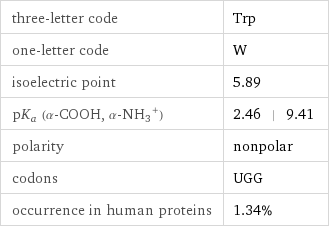
three-letter code | Trp one-letter code | W isoelectric point | 5.89 pK_a (α-COOH, (α-NH_3)^+) | 2.46 | 9.41 polarity | nonpolar codons | UGG occurrence in human proteins | 1.34%
Solid properties (at STP)

density | 1.34 g/cm^3
Units

Chemical identifiers
![CAS number | 73-22-3 Beilstein number | 86197 PubChem CID number | 6923516 PubChem SID number | 8144649 SMILES identifier | C1=CC=C2C(=C1)C(=CN2)CC(C(=O)[O-])[NH3+] InChI identifier | InChI=1/C11H12N2O2/c12-9(11(14)15)5-7-6-13-10-4-2-1-3-8(7)10/h1-4, 6, 9, 13H, 5, 12H2, (H, 14, 15)/t9-/m0/s1/f/h12H InChI key | QIVBCDIJIAJPQS-FKOBDKTLDJ EU number | 200-795-6 RTECS number | YN6130000 NSC number | 13119](../image_source/2dd74e746536e5583c15ce69f047a094.png)
CAS number | 73-22-3 Beilstein number | 86197 PubChem CID number | 6923516 PubChem SID number | 8144649 SMILES identifier | C1=CC=C2C(=C1)C(=CN2)CC(C(=O)[O-])[NH3+] InChI identifier | InChI=1/C11H12N2O2/c12-9(11(14)15)5-7-6-13-10-4-2-1-3-8(7)10/h1-4, 6, 9, 13H, 5, 12H2, (H, 14, 15)/t9-/m0/s1/f/h12H InChI key | QIVBCDIJIAJPQS-FKOBDKTLDJ EU number | 200-795-6 RTECS number | YN6130000 NSC number | 13119
NFPA label

NFPA label
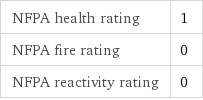
NFPA health rating | 1 NFPA fire rating | 0 NFPA reactivity rating | 0
Toxicity properties

RTECS classes | tumorigen | drug | mutagen | reproductive effector | human data